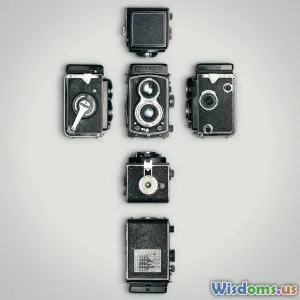
Next Gen Cameras and Equipment
8 min read Explore groundbreaking next-gen cameras and equipment revolutionizing photography and filmmaking today. (0 Reviews)
Next Gen Cameras and Equipment: Transforming Photography & Filmmaking
Photography and filmmaking have always relied on cutting-edge technology to push creative boundaries. But as we stand at the precipice of a new era fueled by artificial intelligence, ultra-high resolution sensors, and intelligent accessories, next-generation cameras and equipment are revolutionizing how visual stories are captured and crafted.
Introduction
Imagine a world where your camera anticipates the perfect moment, autofocuses with lightning precision, and records footage in jaw-dropping clarity. This is not science fiction—it’s the reality ushered in by next-gen technologies reshaping photography and cinematography. Whether you're a professional filmmaker capturing epic narratives or a photographer chasing fleeting light, these advances empower artists like never before.
This article explores the most innovative cameras and equipment redefining the visual arts in 2024 and beyond, revealing how these tools unlock new realms of storytelling.
The Heart of Innovation: Sensor Technology
One foundational leap in next-gen cameras lies in sensor evolution. Sensors dictate image quality, dynamic range, and low-light performance—the raw data from which breathtaking photos and videos spring.
Backside-Illuminated and Stacked Sensors
Traditionally, sensors struggled to balance pixel density with noise reduction. Modern innovations like backside-illuminated (BSI) and stacked sensor designs have upended this paradigm. Sony's IMX989 sensor, for instance, features a 1-inch stacked CMOS design with BSI technology. This architecture enables faster readout speeds and higher sensitivity, yielding stunning 60MP images and ultra-fast 8K video without overheating—a nightmare for prior generations.
Multi-Spectrum and Computational Sensors
Some companies are pioneering multi-spectrum sensors capable of capturing light beyond visible wavelengths, integrating infrared and ultraviolet data. These sensors open artistic and scientific possibilities previously unattainable with conventional cameras.
Computational photography also leverages sensor data with AI algorithms to overcome physical limitations. Techniques such as pixel binning, HDR fusion, and real-time noise reduction offer crisp images even in challenging environments.
Intelligent Autofocus: AI-Powered Tracking
Arguably the most transformative feature in next-generation equipment is AI-driven autofocus (AF). No longer do photographers wrestle with manual adjustments in fast-paced scenarios.
Eye & Subject Tracking
Sony’s Real-Time Eye AF and Canon’s Dual Pixel CMOS AF mark landmark advancements. These systems employ deep learning to identify and lock focus on human and animal eyes, maintaining focus fluently through movement and complex backgrounds. Filmmakers particularly benefit as cinematic shots require sharp focusing that keeps pace with unpredictable action.
Predictive Focusing and Motion Analysis
Latest systems analyze motion trajectories, predicting where subjects will be in the coming frames—an invaluable feature for sports and wildlife photographers. This predictive autofocus ensures critical moments aren’t disappointingly blurred or missed.
Video Capabilities: Beyond 4K
The demand for ultra-high-definition video quality has skyrocketed, with next-gen cameras pushing video capture to new frontiers.
8K Recording and Raw Video
Brands like RED and Blackmagic Design are championing true 8K raw recording. For instance, the RED Komodo 6K camera supports raw footage allowing unparalleled postproduction flexibility, crucial for filmmakers who color grade or crop shots extensively. At the consumer level, Canon’s EOS R5 offers 8K internal recording—a boon for content creators seeking cinema-grade visuals.
High Frame Rates and HDR
Alongside resolution, frame rate capabilities have leapt forward. Cameras now easily support 120fps or more at 4K, and even 240fps in Full HD mode, enabling spectacular slow-motion effects.
Hybrid Log Gamma (HLG) and HDR10 recording standards provide broader color gamut and contrast, ensuring footage is dynamic and lifelike on compatible displays.
Next-Level Accessories: Smarter, Lighter, and More Versatile
Cutting-edge cameras are only one half of the story; next-gen filmmaking and photography gear completes the creative toolbox.
Modular Rigs and Stabilization
Modularity allows users to customize rigs with components such as external monitors, wireless transmitters, and audio units. For example, DJI’s Ronin series integrates intelligent gimbals with AI stabilization algorithms to reduce shake — essential for handheld storytelling.
Drone and AI-Enabled Cameras
Drones like DJI's Mavic 3 Cine bring 5.1K video capture stabilized by advanced flight systems, enabling breathtaking aerial perspectives traditionally requiring helicopters.
AI-assisted tools like frame composition assistants analyze scenes and suggest settings or composition improvements, acting as virtual assistants behind the lens.
Wireless Workflow Integration
Next-gen equipment increasingly supports high-speed wireless data transfer, facilitating seamless on-set collaboration and faster postproduction workflows. Sony and Canon cameras now integrate with cloud platforms and mobile apps for instant sharing.
Real-World Impact: Creators Harnessing New Tools
Filmmaker Chloe Zhao’s Oscar-winning visuals on "Nomadland" were partly realized through lightweight, nimble digital cameras that facilitated spontaneous, vérité-style filming.
Photographer Jimmy Chin combines high-end camera systems with drone footage to craft compelling adventure stories that blend altitude and intimacy.
Survey data from industry reports reveal that 72% of professional photographers and filmmakers intend to upgrade their cameras with AI autofocus and 8K capabilities within the next two years, reflecting growing trust in next-gen tech.
Conclusion
The evolution of next-gen cameras and equipment is not just about technical specs — it’s a renaissance in how stories are told visually. Enhanced sensors capture the subtlest hues and textures; AI autofocus ensures the decisiveness of moments immortalized; 8K and HDR elevate cinematic storytelling to unprecedented realism; and smarter accessories streamline creative workflows.
For photographers and filmmakers seeking to future-proof their craft and inspire audiences, embracing these innovations is key. The tools are becoming extensions of artistic vision itself, removing technical barriers to focus exclusively on creativity.
The future of visual storytelling beckons—equip yourself with next-generation cameras and gear to capture it at its fullest.
“Technology alone isn’t creativity — but creativity is only bounded by technology.” — Renowned Visual Artist Unknown
In 2024, let next-gen cameras and equipment be your gateway to a new creative dimension.
Rate the Post
User Reviews
Popular Posts





















